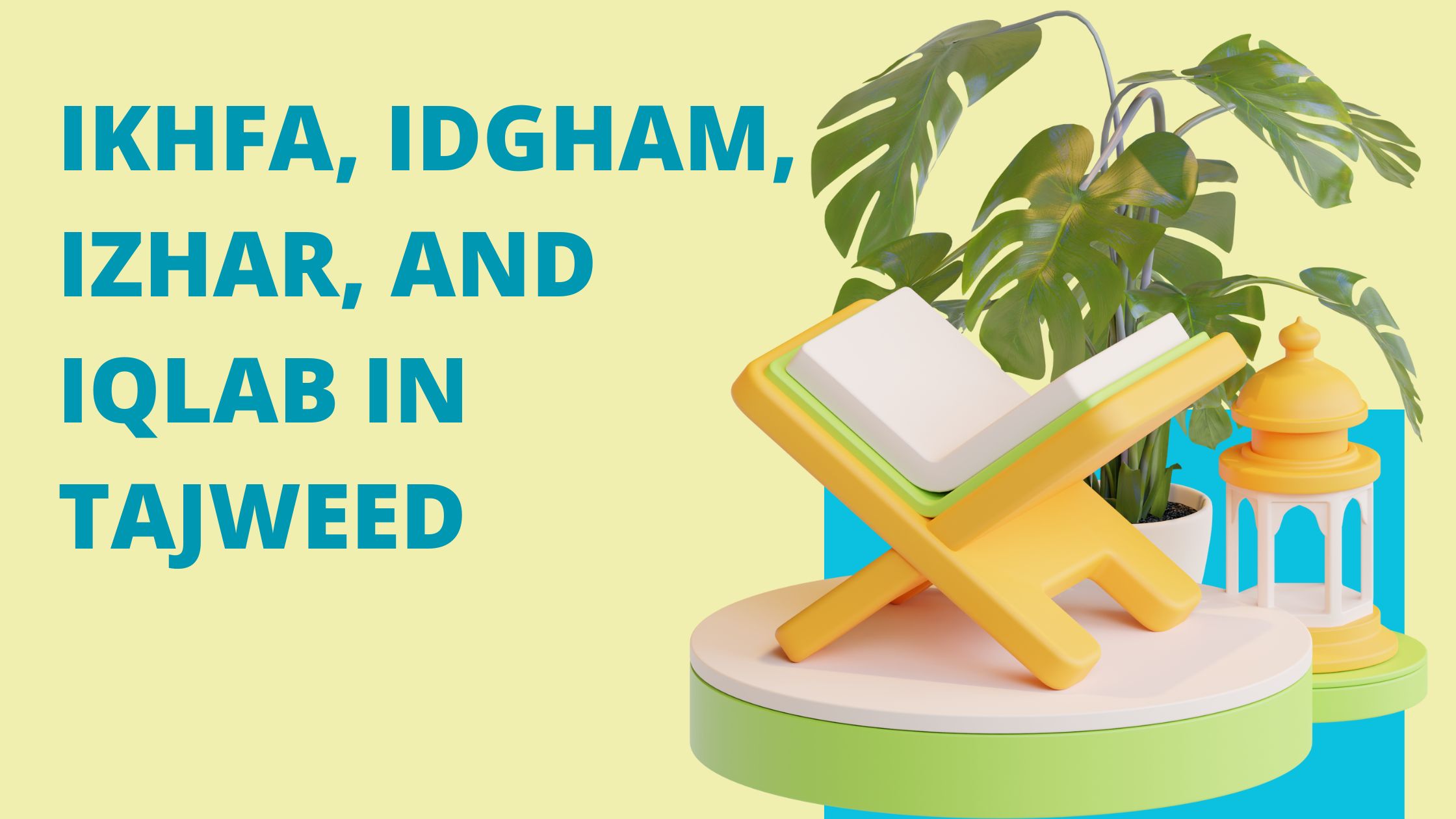In this blog post, we will discuss the differences between Ikhfa, Idgham, Izhar, and Iqlab in Tajweed. Tajweed is a set of rules and guidelines that dictate the proper pronunciation and recitation of the Quran.
Although these four terms are commonly used interchangeably, they refer to distinct rules that greatly impact the pronunciation of certain Arabic letters when reciting the Quran.
Having a clear understanding of these differences is crucial for achieving mastery of Tajweed and reciting the Quran with beauty and accuracy. So, let’s delve into the intricacies of Ikhfa, Idgham, Izhar, and Iqlab in Tajweed.
Table of Contents
What is Izhar in Tajweed?
Izhar in Tajweed refers to the clear pronunciation of the Noon Sakinah or Tanween, without any pause or stress when it is followed by one of the throat letters. The purpose of Izhar is to make the pronunciation of these letters apparent and distinct.
There are six throat letters that trigger the Izhar rule: Hamza ( ء ), Haa ( ه ), Ayn ( ع ), Haa ( ح ), Ghayn ( غ ), and Khaa ( خ ).
An example of Izhar in action can be seen in the verse “مِنْ إِلهٍ” (Quran 7:59), where the Noon Sakinah at the end of the word “إِلهٍ” is followed by the letter Hamza in the next word. In this case, the Noon Sakinah should be pronounced clearly without any ghunnah.
Understanding these rules of Noon Saakin and Tanween is crucial for proper recitation and comprehension of the Quranic Arabic language.
What is Idgham in Tajweed?
Idgham in Tajweed refers to the merging of the pronunciation of Noon Sakinah/Tanween with one of the Idhaam letters. There are many types of Idgham leading to merging results in the formation of a single Mushaddad letter, where the sound of this Mushaddad letter is based on the Mutaharrik letter’s sound.
There are six letters of Idgham: Yaa (ي), Raa (ر), Meem (م), Laam (ل), Waw (و), and Noon (ن). Depending on the Idgham letter used, the Idgham may or may not be accompanied by a Ghunnah of two beats, which is a sound that flows into the nose when pronouncing certain letters.
For example, in the phrase “مِنْ مالٍ” (Noon Sakinah at the end of the word “مِنْ” followed by the letter Meem in the next word), the pronunciation of the Noon Sakinah and Meem will be merged to form a single sound.
What is Iqlab in Tajweed?
Iqlaab in Tajweed refers to the conversion of Noon Sakinah/Tanween into a Meem letter without Harakah ( م ) when preceding an Iqlab letter. The word “Iqlaab” means to change into something else in Arabic.
This occurs when Tanween or Noon Sakinah comes with an Iqlab letter, which is the letter Baa ( ب ) and turns the noon into a meem. It’s important to note that Iqlaab should always be accompanied by a Ghunnah of two beats.
For example, in the word “أَنْبِئْهُمْ” from Quran 2:33, the noon sakina at the end of the verb is followed by the letter Baa in the same word, resulting in the conversion of the noon sakina into a meem.
What is Ikhfa in Tajweed?
Ikhfa in Tajweed refers to the concealment or hiding of the sound of certain letters, specifically when a Noon Sakinah or Tanween is followed by an Ikhfa letter. It is an intermediate phase between Izhaar and Idghaam.
During Ikhfa, the Noon Sakinah/Tanween is not fully pronounced but is also not completely merged into the following letter. Instead, it is accompanied by a nasal sound called Ghunnah for approximately two beats of seconds.
There are fifteen letters known as Ikhfa letters, excluding Izhar, Iqlab, and Idgham. To help remember these Ikhfa letters, an Arabic poem has been created where each word begins with one of the Ikhfa letters. (The poem reads: صِفْ ذَا ثَنَا كَمْ جَادَ شَخْصٌ قَدْ سَمَا ** دُمْ طَيِّبًا زِدْ فِي تُقًى ضَعْ ظَالِمَا)
For example, in the phrase “إِنَّ ٱلۡإِنسَٰنَ لَفِى خُسۡر”ٍ” (verily, mankind is in loss), the second word “ٱلۡإِنسَٰنَ” has a Noon Sakinah in the midst of it, followed by one of the Ikhfa letters. In this case, the pronunciation of the Noon Sakinah is concealed and only the nasal sound (Ghunnah) is heard.
To learn more about the Tajweed rule of Ikhfaa and how to properly apply it in recitation, check out our article “Tajweed Rules For Ikhfaa.” as well as Ikhfaa Shafawi.
Differences between Ikhfa, Idgham, Izhar, and Iqlab
Differences between Ikhfa, Idgham, Izhar, and Iqlab can be explained based on their meanings, the specific letters involved, and the presence or absence of ghunnah (nasal sound).
| Type | Meaning | Letters | Ghunnah |
|---|---|---|---|
| Izhaar | Izhaar refers to the clear pronunciation of Noon Sakinah (silent noon) and Tanween (double vowels) when followed by an Izhar letter. | Izhaar is applied when the following letters appear after Noon Sakinah or Tanween: Hamza ( ء ), Haa ( ه ), Ayn ( ع ), Haa ( ح ), Ghayn ( غ ), and Khaa ( خ). | Izhaar is performed without ghunnah. The sound of Noon Sakinah or Tanween is pronounced clearly and separately from the letter following it. |
| Idgham | Idgham involves merging or mixing Noon Sakinah or Tanween with the Idgham letter, resulting in a single prolonged consonant sound known as the Mushaddad letter. | Idgham is applied when the following letters appear after Noon Sakinah or Tanween: Yaa (ي), Raa (ر), Meem (م), Laam (ل), Waw (و), and Noon (ن). | Idgham can be performed with or without ghunnah, depending on the specific rules. It may involve nasalizing the merged sound or pronouncing it without nasalization. |
| Iqlaab | Iqlaab refers to the transformation of Noon Sakinah or Tanween into the sound “Meem” when followed by a Baa letter. | Iqlaab is only applicable when the letter “Baa” ( ب ) appears after Noon Sakinah or Tanween. | Iqlaab is performed with ghunnah. The sound of Noon Sakinah or Tanween is hidden, and instead, the sound “Meem” is pronounced with nasalization. |
| Ikhfaa | Ikhfaa involves hiding or suppressing the sound of Noon Sakinah or Tanween with a slight nasal sound. | Ikhfaa is applied when the letter following Noon Sakinah or Tanween does not fall under the categories of Izhaar, Idgham, or Iqlaab. | Ikhfaa is performed with ghunnah. The sound of Noon Sakinah or Tanween is not pronounced clearly but is rather subtly merged with the following letter, creating a nasalized sound. |
Learn the complete set of rules for reciting the Quran with accuracy and beauty in this comprehensive guide to Tajweed.
The Importance of Ikhfa, Idgham, Izhar, and Iqlab in Tajweed
Understanding and implementing the rules of Ikhfa, Idgham, Izhar, and Iqlab is crucial in Tajweed as they enhance the beauty, clarity, and fluency of reciting the Quran.
These rules ensure accurate pronunciation of each letter, preserving the integrity of words and verses. Adhering to these rules allows reciters to effectively convey the intended meanings of the Quran.
Mastering Ikhfa, Idgham, Izhar, and Iqlab enables reciters to recite the Quran with precision, creating a harmonious and melodious recitation that reflects the divine beauty of the scripture.
Enroll Your Kids in our Bayan Al-Quran Academy for Quran and Tajweed Learning with Certified Tutors
At Bayan Al-Quran Academy, we offer comprehensive Quran and Tajweed learning for kids programs specifically designed for children. Our academy is dedicated to providing a nurturing and engaging environment where children can learn the importance of reciting the Quran with proper Tajweed rules.
With our experienced teachers, innovative teaching methods, and interactive learning materials, we ensure that each child receives personalized attention and guidance throughout their journey of learning.
Whether your child is a beginner or already familiar with the basics of Tajweed, our courses cater to all levels of proficiency. Join us at Bayan Al-Quran Academy to give your child the opportunity to develop a strong connection with the Quran while mastering the art of correct recitation through Tajweed.
Conclusion
It is important to have a thorough understanding of the concepts of Izhar, Idgham, Iqlab, and Ikhfa, as well as the distinctions between them, to master Tajweed. Each of these terms pertains to specific rules and techniques for correct recitation of the Quran.
By incorporating these principles into your recitation, you can enhance your comprehension of Tajweed and improve your overall fluency in reciting the Quran.
If you want your children to excel in their Quran studies, enroll them in Bayan Al-Quran Academy where they will receive expert guidance from certified tutors. Start their journey towards becoming proficient reciters today!

















